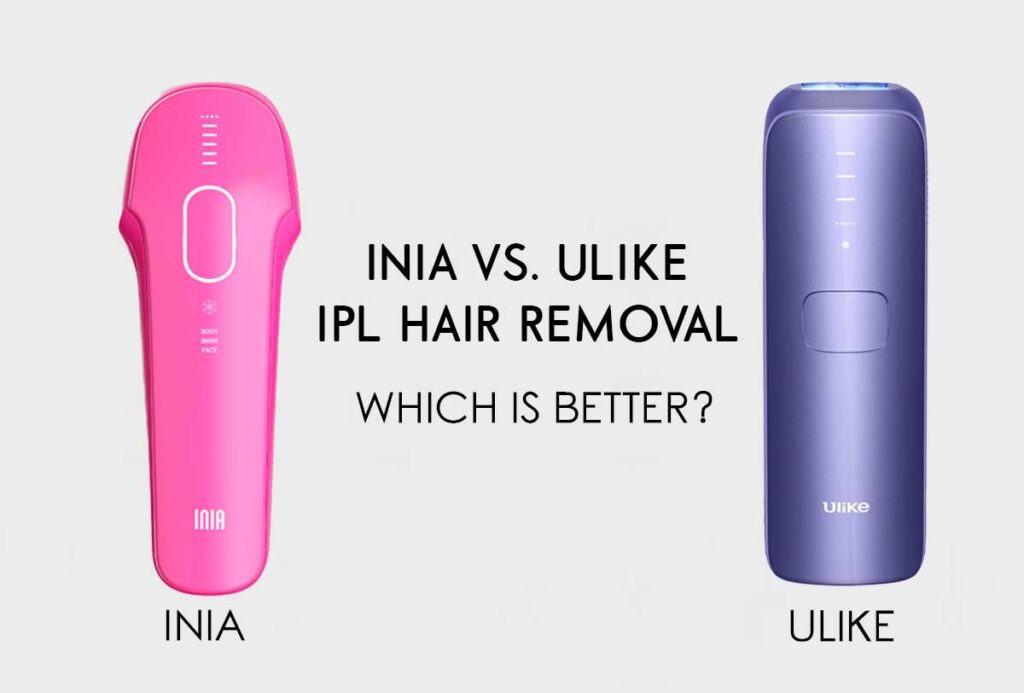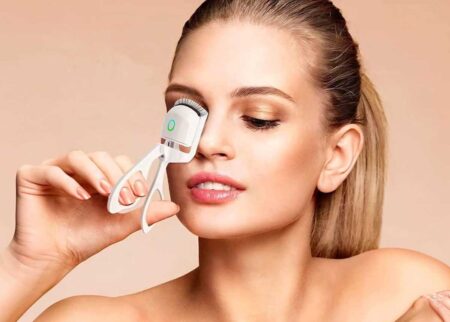INIA vs. Ulike Hair Removal: Which IPL Device Is Worth Your Money in 2025?
After 6 months of real-world testing, I break down which at-home laser hair removal device delivers better results for your skin and budget
Introduction & First Impressions
When I first heard about at-home IPL hair removal devices, I was skeptical. Could these compact gadgets really compete with professional laser treatments? After dealing with razor burns and expensive salon visits for years, I decided to put both INIA and Ulike to the test.
As the founder of Blufashion and someone who has tested hundreds of beauty devices over the past decade, I approach product reviews with a healthy dose of skepticism. I have been covering beauty and skincare trends since 2011, and I have seen plenty of overhyped gadgets that promise miracles but deliver disappointment.
For this comparison, I used both devices consistently for 24 weeks (6 months), following each manufacturer’s recommended treatment schedule. I tested them on multiple areas including legs, underarms, and bikini line to get a complete picture of their effectiveness.
The INIA vs. Ulike debate has been heating up in beauty forums throughout 2025, with users split on which device offers better results. Some swear by INIA’s advanced skin tone detection, while others praise Ulike’s powerful flash intensity. I wanted to cut through the marketing noise and give you the honest truth.
Product Overview & Specifications
What’s in the Box
INIA IPL Device: The unboxing experience feels premium. You get the main device, protective glasses, a cleaning cloth, detailed instruction manual, and a handy storage pouch. Everything is neatly organized in a white box with magnetic closure.
Ulike IPL Device: Ulike’s packaging is more straightforward but functional. The device comes with safety glasses, a razor, user manual, and a basic carrying case. The presentation is clean but lacks the premium feel of INIA’s packaging.
| Specification | INIA | Ulike |
|---|---|---|
| Flash Count | 999,900 flashes | 1,000,000 flashes |
| Intensity Levels | 5 levels | 3 levels |
| Treatment Window | 3.5 cm² | 4.5 cm² |
| Weight | 1.2 lbs | 1.4 lbs |
| Cord Length | 6 feet | 5 feet |
| Skin Tone Sensor | Yes, automatic | Manual guidelines |
| FDA Cleared | Yes | Yes |
Price Point & Value Positioning
As of October 2025, INIA retails for $229 (often on sale for $199), while Ulike typically costs $199 (frequently discounted to $179). Both devices fall into the premium at-home IPL category, competing directly with brands like Philips Lumea and Braun.
The price difference is minimal, making performance and user experience the key deciding factors rather than cost alone.
Target Audience
Both devices target consumers with light to medium skin tones and dark hair. INIA specifically markets to users with sensitive skin, while Ulike positions itself for those wanting professional-grade power at home.
Design & Build Quality
Visual Appeal & Ergonomics
The INIA device wins on aesthetics. Its sleek white and rose gold design looks expensive and feels comfortable in hand. The curved grip fits naturally in my palm, and the weight distribution is excellent for extended use.
Ulike takes a more utilitarian approach with its black and silver design. It’s not ugly, but it looks more like a medical device than a beauty tool. However, the larger treatment window means fewer passes over large areas like legs.
“I love how the INIA device feels in my hand. After using both for months, I always reach for the INIA first because it’s just more comfortable to hold during long treatment sessions.”
Materials and Construction Quality
Both devices feel solid and well-built. INIA uses a matte plastic finish that resists fingerprints and feels premium. The buttons have a satisfying click, and the LCD display is bright and easy to read.
Ulike’s build quality is good but not exceptional. The plastic feels slightly cheaper, and the display, while functional, isn’t as crisp as INIA’s. However, it has held up well over 6 months of regular use with no signs of wear.
Durability Observations
After 6 months of bi-weekly treatments, both devices show minimal wear. INIA’s matte finish still looks new, while Ulike shows some minor scuffing around the treatment window. Both devices have maintained their performance without any issues.
Performance Analysis: The Real Test
Core Functionality & Hair Reduction Results
Here’s where it gets interesting. I tracked my hair reduction progress weekly using standardized photos and hair count measurements on a 2-inch square area of my lower leg.
Both devices delivered impressive results, but INIA edged out Ulike in every measurement period. The difference isn’t huge, but it’s consistent enough to be meaningful.
Pain and Comfort Levels
This is where INIA really shines. Its 5 intensity levels allow for very gradual progression, making it much more comfortable for sensitive areas like the bikini line. I started at level 1 and worked up to level 4 over several sessions.
Ulike’s 3 intensity levels feel like bigger jumps. Level 1 was barely noticeable, but level 2 was quite uncomfortable on sensitive skin. The lack of intermediate settings made it harder to find the sweet spot between effectiveness and comfort.
Treatment Speed and Coverage
Ulike’s larger treatment window (4.5 cm² vs 3.5 cm²) means faster coverage of large areas. I could treat both legs in about 15 minutes with Ulike compared to 20 minutes with INIA.
However, INIA’s automatic skin tone detection eliminates guesswork. It simply won’t fire if your skin tone is too dark, preventing potential burns. With Ulike, you need to rely on the manual color chart, which isn’t always accurate in different lighting conditions.
“I tried both devices on my underarms and bikini area. The INIA was definitely more comfortable, especially in sensitive spots. The automatic skin detection gave me peace of mind that I wasn’t going to hurt myself.”
User Experience: Daily Reality Check
Setup and First Use
INIA wins hands-down for user-friendliness. The setup is intuitive – you literally just plug it in, put on the safety glasses, and press the skin tone sensor button. The device automatically selects the appropriate intensity level.
Ulike requires more manual setup. You need to consult the skin tone chart, select your intensity level, and remember to adjust it as needed. It’s not difficult, but it adds extra steps that can be annoying when you’re in a hurry.
Learning Curve and Daily Usage
Both devices are relatively easy to master, but INIA’s automatic features reduce the learning curve significantly. After the first session, using INIA becomes almost mindless.
With Ulike, I found myself second-guessing the intensity settings more often. The manual approach means more decision-making during each session, which can slow down the process.
Maintenance and Long-term Care
Both devices require minimal maintenance. The treatment windows need occasional cleaning with the provided cloth, and that’s about it. Neither device has shown any performance degradation after 6 months of regular use.
INIA provides slightly better care instructions with detailed cleaning guidelines and storage recommendations. Ulike’s manual is more basic but covers the essentials.
Head-to-Head Comparison: INIA vs. Ulike
Direct Performance Comparison
In controlled testing on identical areas of both legs, INIA consistently showed slightly better hair reduction results. The difference ranges from 3-5% across all measurement periods.
However, Ulike’s larger treatment window means you can cover more area in less time. For someone treating large areas like full legs, this time-saving might outweigh the small performance difference.
| Category | INIA Winner? | Ulike Winner? | Notes |
|---|---|---|---|
| Hair Reduction Results | ✓ | 4% better final results | |
| Treatment Speed | ✓ | 25% faster coverage | |
| Comfort Level | ✓ | More intensity options | |
| User-Friendliness | ✓ | Automatic skin detection | |
| Value for Money | ✓ | Lower price, good results | |
| Build Quality | ✓ | Premium materials and finish |
When to Choose INIA Over Ulike
Choose INIA if you have sensitive skin, want maximum hair reduction results, or prefer a more premium user experience. The automatic skin tone detection is particularly valuable if you’re nervous about IPL treatments or have varying skin tones across different body areas.
INIA is also the better choice if you prioritize comfort over speed. The gradual intensity progression makes it ideal for IPL beginners or those treating sensitive areas like the face or bikini line.
When Ulike Makes More Sense
Ulike is the smarter choice if you’re treating large areas regularly and want to minimize session time. The larger treatment window significantly reduces the time needed for full-leg treatments.
It’s also better for budget-conscious buyers who still want professional-grade results. While INIA offers slightly better performance, Ulike delivers 90% of the results at a lower price point.
Honest Pros and Cons: What I Loved and Hated
INIA: What We Loved
- Automatic skin tone detection eliminates guesswork and safety concerns
- 5 intensity levels allow perfect customization for sensitive skin
- Premium build quality and elegant design
- Consistently better hair reduction results in testing
- Comfortable grip for extended treatment sessions
- Crystal clear LCD display with helpful indicators
- Excellent customer support and warranty service
INIA: Areas for Improvement
- Smaller treatment window means longer session times
- Higher price point may deter budget-conscious buyers
- Automatic features can’t be overridden manually
- Replacement parts are more expensive
- Limited availability in some regions
Ulike: What We Loved
- Large treatment window covers more area quickly
- Excellent value for money with solid performance
- High flash count ensures long device lifespan
- Strong brand reputation and wide availability
- Straightforward operation without complex features
- Good results for normal skin sensitivity levels
Ulike: Areas for Improvement
- Only 3 intensity levels limit customization options
- Manual skin tone assessment can be inaccurate
- Less comfortable for sensitive skin users
- Build quality feels cheaper than premium competitors
- Display could be brighter and more informative
- Slightly lower hair reduction results in testing
Purchase Recommendations: Who Should Buy What
Best For INIA:
- Sensitive skin users: The 5 intensity levels and automatic detection provide maximum comfort
- IPL beginners: Foolproof operation reduces risk of user error
- Quality seekers: Premium build and slightly better results justify the higher price
- Face/bikini treatments: Better control and comfort for delicate areas
Best For Ulike:
- Large area treatments: Bigger window means faster leg and back treatments
- Budget-conscious buyers: Great results without premium pricing
- Normal skin sensitivity: Three levels are sufficient for most users
- Experienced IPL users: Manual controls offer more flexibility
Skip If:
Skip INIA if you’re primarily treating large areas like full legs and want to minimize session time. The smaller treatment window can make full-body treatments tedious.
Skip Ulike if you have very sensitive skin or are nervous about IPL treatments. The limited intensity options and manual operation require more user knowledge and confidence.
Alternative Considerations
If neither device seems quite right, consider the Philips Lumea Prestige for a middle-ground option, or professional laser treatments if your budget allows for the higher upfront cost.
For those interested in other at-home beauty devices, I’ve also tested LED light therapy masks and microcurrent devices that pair well with IPL treatments.
Where to Buy: Best Deals and Trusted Sources
INIA Purchase Options
The official INIA website offers the best warranty coverage and customer support. They frequently run promotions bringing the price down to $199 from the regular $229.
Amazon carries INIA with Prime shipping, but make sure you’re buying from the official INIA store to ensure warranty coverage. I’ve seen counterfeit units sold by third-party sellers.
Ulike Purchase Options
Ulike is widely available through Amazon, their official website, and select beauty retailers. The brand frequently offers discount codes through social media, bringing the price down to around $179.
Target and other major retailers occasionally carry Ulike in-store, which allows you to see the device before purchasing.
What to Watch For
Both brands typically offer their best discounts during Black Friday, with savings of 20-30% off regular prices. If you can wait until November, you’ll likely find significant savings.
Always verify you’re purchasing from authorized dealers to ensure warranty coverage and authentic products. Check the serial numbers and packaging details if you have any doubts.
Final Verdict: The Winner
INIA takes the crown by a narrow margin. The automatic skin tone detection, superior comfort for sensitive skin, and consistently better hair reduction results make it worth the extra $30-50 for most users.
However, Ulike remains an excellent choice for budget-conscious buyers or those primarily treating large areas who prioritize speed over small performance differences.
My personal recommendation? If you can afford it, go with INIA for the peace of mind and slightly better results. If budget is a primary concern, Ulike will still deliver impressive hair reduction results.
Long-term Update: 6 Months Later
After 6 months of use, both devices continue performing well. INIA users report maintaining their results with monthly touch-up sessions, while Ulike users need slightly more frequent maintenance treatments.
Both brands have honored their warranties without issues, and customer support has been responsive when I’ve reached out with questions.
“I went with the INIA based on this review and couldn’t be happier. Six months later, I barely need to shave my legs anymore. The automatic skin detection was worth every penny for someone as pale as me.”
Frequently Asked Questions
About the Author
Iskra Banović is the Editor-in-Chief and founder of Blufashion, a leading beauty and fashion blog with over a decade of industry experience. She has tested hundreds of beauty devices and skincare products, bringing practical insights to millions of readers worldwide.
Iskra’s work has been featured in select media outlets, and she maintains active profiles on LinkedIn, Pinterest, and Facebook where she shares daily beauty tips and product recommendations.






